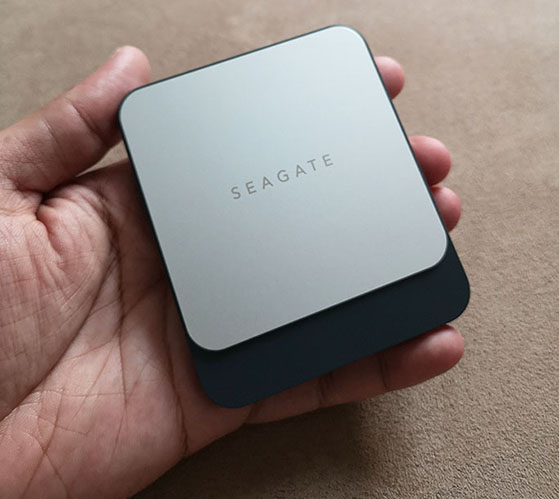For the most part, high-speed SSDs (solid state drives) are limited to internal drives in PCs, enabling quick boot times, and all-round high responsiveness. Portable storage usually being limited to small flash drives or conventional mechanical hard drives for larger storage needs. All that changes with the Fast SSD from Seagate, a solution for high mobility and speed on the go.




Design and Package
The dimensions are quite slick, allowing for easy carrying in the pocket, at a weight of just 81.65 grams. What’s even better is the lack of rotating platters and moving heads like a conventional hard-drive (HDD), which means it’s relatively more durable and shock-resistant.


Currently it’s available in four capacities: 250GB, 500GB, 1TB, and 2TB. The test unit we are reviewing is the 500GB variant.
The device has just one port — a USB Type-C. The housing is made of plastic, with a steel plate atop with the Seagate branding. Included cables are a USB Type-C to Type-A, and a USB Type-C at both ends. Being a low power device, no DC power connector is required.


There is a tiny LED beside the USB port that lights up when connected to a computer. Side by side with a slim portable Seagate HDD, the Fast SSD is both smaller and slightly thinner.

Specs and Performance
The combination of an SSD on a USB 3 interface should make it possible for some pretty impressive data transfer speeds.

How we tested:
To ensure ample read speeds, all the copy testing was done from an internal NVME SSD. The file being used was a 10.8GB MKV video file. All drives being copied to were external drives connected via USB 3
Copying to the Seagate Fast SSD 500GB
- Average transfer speed: 370-380 MBps
- Time Taken: 35 secs

Copying to a Seagate Backup Plus HUB 8TB HDD
- Average transfer speed: 130-138 MBps
- Time Taken: 1 min 20 secs

Copying to a Seagate Backup Plus Slim 500GB HDD
- Average transfer speed: 102-114 MBps
- Time Taken: 1 min 45 secs

Also worth keeping in mind that the transfer performance of drives is degraded and much slower when the drive is filled up (>50%). Similarly, the USB 3 bus is shared, so simultaneous activity from various USB devices can also impact throughput.
Copying to a Seagate Backup Plus Slim 500GB HDD (under degraded conditions)
- Average transfer speed: 12-14.5 MBps
- Time Taken: ~15 mins

The results speak for themselves. The Fast Seagate SSD is blistering fast! It exceeds traditional HDDs by well over double the speed; 375 MBps vs. 135 MBps is beyond impressive.
If you transfer a lot of large files between devices or want to work with video content of an external source, the Seagate Fast SSD would be perfect. Especially when say working with Adobe Premiere and needing quick access to video footage.
Software
For general use, the device is pretty much plug-n-play. Hook it up to an available USB 3 port and Windows immediately identifies the drive and lists it in My Computer. The drive is pre-formatted and ready to go. So in essence, no special software or setup is required. I did all of my tests on a 64-bit Windows 10 Professional system. The device is also Mac OS compatible.

The Toolkit software from Seagate allows for easy backup and file syncing / mirroring. The user interface is simple and intuitive, with wizards for both novice and advanced users. Backup is easy, either by file type, be it Music or Videos, or by Windows Drives.


Value
The Seagate Fast SSD 500GB is listed at an SRP of P5,999. There is a considerable premium you’ll be paying for the SSD speed, as a traditional slim portable Seagate HDD of the same size only costs P2,650. Going up to 1TB further widens the gap, the HDD coming in at just over P4000, while the SSD is more than P11,000. The drives currently sell with a 3-year warranty.
On the flip side, it’s worth noting that prices have been coming down. About a year ago the same 500GB SSD was listed at P8,000. Perhaps with more mainstream adoption and popularity, the economies of scale will further drive down the price for the consumer.



At the end of the day, the cost can perhaps be justified if your use case requires the speed. There are undoubtedly situations where the SSD would make a world of difference. On the other hand, if the drive is just an offline backup for documents or photographs, a traditional portable HDD would be a better bang for your buck. I’ve talked about the cost per GB in past reviews, and large HDDs are the way to go if you need space.


Conclusion
So what do you plan to use portable storage for? If you edit video on the go and work with a laptop, the Fast SSD will make for a great companion. Offering speedy access to data on it, especially if you need to read and write to the device actively. Or if you just want something light and portable, again the Fast SSD is perfect. If you want to keep costs low or need a lot of storage space, a traditional hard-drive will better suit your needs.
Given its ease of use and connectivity, and paired with the included backup software, the Seagate Fast SSD 500GB is well suited if you want a hassle-free, ultra-quick backup experience.
Model: STCM500401
Price: P5,999
Verdict: Making speed and portability mainstream!




